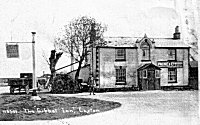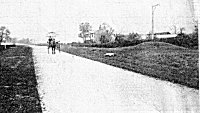

Hangmans Gibbet
A mile and a half from Caxton, at what was the crossroads, there exists a replica gibbet, a grim reminder of the history of the place. Gibbeting was the punishment for some capital offences including highway robbery. An iron cage would have hung from the wooden arm of the original gibbet. Here criminals were hung, imprisoned in the cage until they were dead. The head was clamped at the top to prevent tired legs from resting and the person would slowly starve to death, or in the winter succumb to exposure. The body would remain suspended for some time after death as a warning to others.The original gallows stood on Caxton Common and open area of land that surrounded the junction which was part of Kingís Field. The replica gibbet is thought to have been constructed from the timbers of a nearby cottage.

There are, not surprisingly, a number of tales about the people to have died on the gibbet. The most common tale relates to the robbery and murder of the Partridge family, in Monk Field, Bourn in the 18th century. The murderer fled to America but returned to England after 7 years. After spending some time in a local pub, drink loosened his tongue and he alluded to fleeing the place because he had poached some partridges. The publican believed him to be referring to the unsolved murders and called the police. The man was then arrested and sentenced to be hung in the cage and starve to death.
Another variation tells of a man named Jack Williamson who had a black lurcher called Flash whom he adored. Flash became ill and died after 2 weeks. Knowing Albert Partridge had envied Flash, Williamson became convinced he had killed his beloved dog. The two men met and Williamson struck Partridge. He then, unusually for him, began drinking and muttered about Partridges. When Albertís body was found Williamson was therefor linked to his death. He was gibbeted alive. A baker who took pity on him and offered him bread suffered the same fate.
Legend has it that a landlord of a nearby inn murdered three travellers but was found out and hung on the gibbet.
In 1676 a highwayman called Christopher Ewings was hung here. On 10 August 1745 Footmass and Jerroms were hung for robbing Mr William Wright, a horse dealer of his gold on 12 February 1744.

The area is a place with a lot of history. The bodies of suicides were traditionally buried at crossroads as they were not allowed to be buried in consecrated ground. It is not clear whether this happened at this particular crossroads though. Here the A1198 (the old Roman road) and the A428 meet. Nearby used to be the Caxton Gibbet airfield. In September 1939 it was used as a satellite for Bassingbourn but from 1940 it was used by 50 group as a landing area for No 22 Elementary Flying School. The inn nearby (the original would have been 18th century) catered for viewers of the gibbeting.
Compiled by Angela Bloom CPRS












Sources
http://www.rootsweb.com/~engcam/PlacesBuildings/CaxtonGibbet.htm
http://www.roll-of-honour.com/Regiments/CountyAirfields.com
http://www.ely.anglican.org/parishes/papworth/teamarea2.hm
Cambridgeshire Journal. February 2001. Pp11-13
Cambridgeshire Collection. RO6 2904. David Mossop. Caxton Gibbet